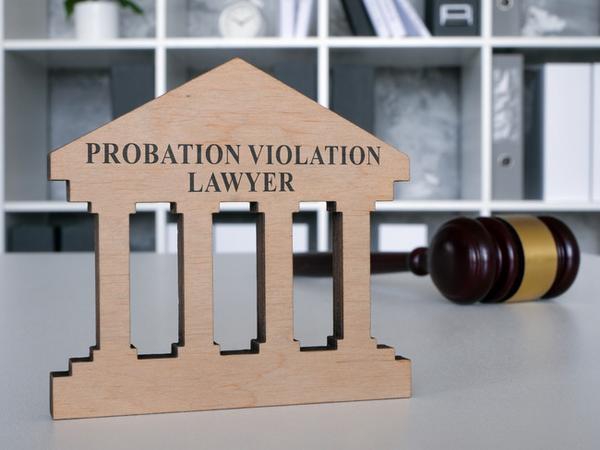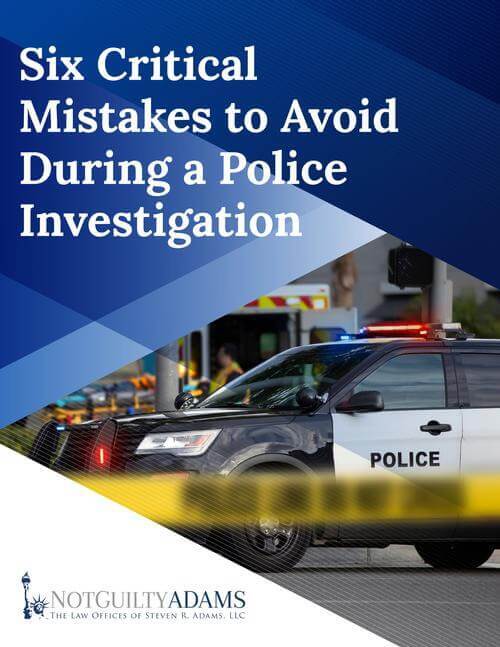It is easy to become overwhelmed after an arrest, especially if you don't have a criminal defense attorney. The police may have released you with a citation to appear in court, offering little explanation of what to expect or what could happen if you are found guilty. While the police, prosecutor, and judge have all been through this before, you have never been in this position and have no idea how the criminal process works. You just want to put the whole thing behind you, even if it means trusting the police to advise you—or even pressure you—into accepting a lesser sentence.
The truth is, an arrest or criminal charge can follow you for the rest of your life. If you do not have someone to advise you on your legal options, your arrest could impact your freedom, privacy, career, and family for years into the future.
How the Criminal Process Works
For 25 years, The Law Offices of Steven R. Adams, LLC has been successfully defending individuals charged with crimes throughout Southern Ohio. Many of our clients are facing the judicial system for the first time and have no idea how the criminal process works. Here is a breakdown of the criminal process:
Investigation of a Crime![Investigation Cincinnati Criminal Defense Attorney]()
Investigations occur in two forms: reactive and proactive. Reactive investigations take place daily and are the most common form of investigation. Think of the police officer who responds to a call for assistance after a crime has occurred.
The police arrive and do the following:
- Speak with the victim and witnesses
- Locate evidence
- Complete a report
- An arrest is made at the scene or shortly thereafter
If a suspect is not identified or needs to be interviewed, the report is passed along to an investigator or detective. Proactive investigations start with a tip regarding criminal activity and end with an arrest. The police officer or detective looks into the information provided and attempts to determine if there is enough evidence to identify a suspect and support an arrest. Proactive investigations are conducted using undercover operations or confidential informants. The police officer must be careful to avoid entrapment issues. Opportunities to commit a crime can be created, but criminal activity cannot be compelled.
![Arrested Arrested For A Crime]() Arrest of an Individual
Arrest of an Individual
An arrest occurs when an individual is taken into custody and is no longer free to leave. A person can be placed under arrest without ever being handcuffed. An arrest involves some type of submission, whether voluntary or involuntary, to a police officer. Arrests typically occur after a police officer witnesses a crime, after probable cause to make an arrest has been established, or after an arrest warrant has been executed. Depending on the crime and arresting agency, the subject is either cited to court and released or transported to jail.
What is Bail or Bond?
This is an amount, either monetary or in the form of property, which will be used to ensure the defendant returns for future court hearings and trial proceedings. According to the Eighth Amendment in the U.S. Constitution, “Excessive bail shall not be required.” The judge is responsible for setting a bond amount that will allow the defendant to remain free until the conclusion of the case. An Own Recognizance (OR) bond can be given instead of requesting money or property.
Depending on the individual case, preventative detention may be necessary to ensure the defendant returns for a trial. For example, it would be inconceivable for an individual to have a low bond when he or she is accused of a heinous and violent crime leading to serious harm or the death of another. In these cases, judges set the bond amount so high that it is unlikely the individual will be out of jail pending completion of the case. Additionally, a bond may be denied if a judge fears the defendant will not return for future hearings or is apt to threaten and harass the victim while free.
Judges consider many factors when deciding a bond amount:
- The seriousness of the crime and any harm caused to the victim plays an important role.
- Strong ties to the community
- The nearby presence of family and friends will encourage a return to court
- Past criminal history
- Employment history
- Previous compliance or non-compliance with any bonds in past cases
The bond amount is returned after the case if the defendant shows up for all court appearances. Otherwise, the court may hold onto the money or property pledged for the defendant’s return. Judges can require different payment amounts for bonds before releasing a defendant. For example, a judge may require 10% of the bond amount or 100% prior to releasing a defendant. Bail bondsmen normally keep 10% of the full amount of the bond for their services, even if the defendant appears for all future hearings. The clerk’s office charges small fees when processing the bond.
The Arraignment
An arraignment is the first appearance before a judge. The charges against you are read, and you can enter a guilty or not guilty plea. This is also an opportunity to request an attorney or have an attorney speak up on your behalf. Future court hearings are set following an arraignment hearing. Most likely, the matter will be set for a pre-trial to allow the accused to obtain counsel. If counsel already represents the accused, a pre-trial hearing allows the attorney to obtain discovery or evidence the government intends to use against the defendant to try and secure a conviction.
The Grand Jury
A defendant must be indicted by a grand jury for felony cases in Ohio. The grand jury decides whether there is probable cause to bring charges against you, even if you have already been arrested on these same charges. If the grand jury agrees with the charges, it issues an indictment or formal charge. If the grand jury finds probable cause that a crime occurred, they can indict on felony charges or amend the charge to a misdemeanor. A grand jury can ignore the charges as well. Grand jury proceedings are secret in nature. The defendant and his or her attorney are not present for this hearing, although there are exceptions.
Plea Bargaining
The majority of all convictions result from some type of plea bargain prior to trial. Negotiations and deals can be struck at any time prior to the conclusion of the trial.
A plea bargain involves an agreement between the prosecution and defense to:
- Reduce the charges
- Drop some or all of the charges
- Plead guilty to a charge in exchange for a specific sentence.
Plea bargaining happens for numerous reasons. It allows the court and everyone involved to avoid a lengthy trial by moving the case through the system quickly and clearing crowded court calendars. It affords the defendant the opportunity to obtain a lighter sentence in exchange for a different charge. Because trial outcomes can be unpredictable even in the most straightforward cases, a plea bargain guarantees some type of conviction for the prosecution while affording the defendant some type of satisfactory outcome of the case, i.e., reduced charges, a lighter sentence, or both. Particularly in drug cases or in cases involving other defendants (co-defendant), a plea bargain may be used to secure testimony against another defendant.
![Trial Trial]() The Trial
The Trial
According to the Sixth Amendment in the U.S. Constitution, “In all criminal prosecutions, the accused shall enjoy the right to a speedy and public trial, by an impartial jury of the State and district wherein the crime shall have been committed, which district shall have been previously ascertained by law, and to be informed of the nature and cause of the accusation; to be confronted with the witnesses against him; to have compulsory process for obtaining witnesses in his favor, and to have the Assistance of Counsel for his defense.”
Remember, most cases never make it to trial. However, depending on the specific circumstances, a trial will be necessary.
There are two different types of trials:
- Bench trial – During a “bench trial”, a judge will consider evidence presented by both side and decide whether a defendant is guilty or innocent. The judge will then determine the penalties. Bench trials are less formal, quicker proceedings than jury trials, and may benefit defendants in various ways. For example, complicated legal issues might not make much sense to a jury whereas a judge will be able understand the legal elements involved. Cases involving controversial issues or sensitive facts may also not fare well with a jury. It is often easier to admit evidence in a bench trial rather than a jury trial.
- Jury trial – A jury for a felony case consists of 12 members, plus two alternates. A jury for a misdemeanor case is comprised of 8 people, plus one alternate. These randomly selected individuals or “peers” consider evidence and determine whether a defendant is guilty or innocent. In some cases, a jury may be more sympathetic than a judge. Since the decision must be unanimous, it is possible to obtain a not guilty or hung jury verdict so long as one juror is swayed in favor of the defendant. If a verdict is not reached, the defendant may be offered a plea bargain to avoid another lengthy trial. The jury does not determine punishment in Ohio. The jury is responsible for deciding punishment in Kentucky.
Sentencing
A judge makes a decision regarding sentencing in criminal matters. Sentencing takes place either immediately after the conclusion of the trial or is set for a later date. Attorneys submit evidence and arguments in support of a desired sentence. Mitigation is offered by defense attorneys in an attempt to achieve a lighter sentence. The defendant is afforded the opportunity to speak on his or her own behalf during sentencing.
The defendant can be sentenced to:
- Jail and/or prison time
- Home incarceration
- Pay fines and restitution
- Probation
- A suspended sentence
When deciding on a sentence, the judge considers input from the prosecution, defense, victim, and, if applicable, the probation department. The sentence is based on past criminal history, the nature of the crime, any injuries sustained by the victim, and expressions of guilt or remorse.
An Appeal![Criminal Defense Attorneys Criminal Defense Attorneys]()
An appeal is a request to a higher court to review, reverse, and/or overrule a decision made by the trial court. Appellate courts do not hear new evidence or testimony. Rather, the judges consider whether an error of law has occurred and if sentencing guidelines were followed. The judges review briefs submitted by the attorneys, trial transcripts, and trial exhibits when making their decisions. The court can reverse or change the decision entirely or in part, affirm or agree with the decision, or remand (return) the case to the trial court for reconsideration. Appeals can also be used for a variety of trial issues. Oftentimes, pre-trial evidence motion hearings may be appealed. For example, a motion to suppress evidence hearing may be appealed.
Contact a Cincinnati Criminal Defense Attorney Today
If you are facing criminal charges, you need to speak with an experienced criminal defense attorney as soon as possible. The Law Offices of Steven R. Adams is recognized by Super Lawyers, Best Lawyers, The Best Lawyers in America, National Trial Lawyers Top 100, and is one of U.S. News' Best Law Firms. Please contact us online or call our Cincinnati office directly at 513-929-9333 to schedule your free consultation. If you're not ready to talk but still want to learn more about your rights, allow us to mail you a complimentary copy of Six Mistakes to Avoid During a Police Investivation.

























 Arrest of an Individual
Arrest of an Individual  The Trial
The Trial




